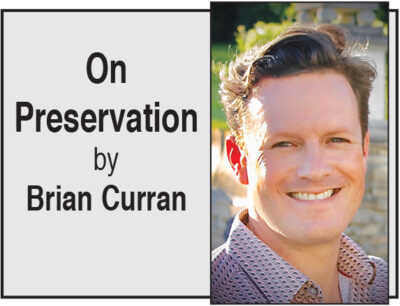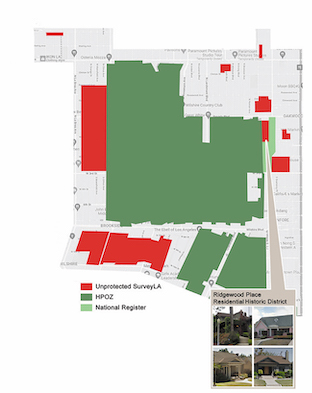Ridgewood Place, a lost gem and overlooked subdivision
 As we continue with our exploration of the undesignated historic districts of Greater Wilshire, our next stop is the SurveyLA identified Ridgewood Place Residential Historic District. This shady lane wedged between the Windsor Square Historic Preservation Overlay Zone (HPOZ) and the Wilton Historic District is a single-family residential neighborhood that includes lots on both sides of North Ridgewood Place, from just south of Beverly Boulevard to First Street. It is an overlooked remnant of the long-lost subdivision of Ridgewood Park, whose origins, like Windsor Square’s and Fremont Place’s, reach back more than a century.
As we continue with our exploration of the undesignated historic districts of Greater Wilshire, our next stop is the SurveyLA identified Ridgewood Place Residential Historic District. This shady lane wedged between the Windsor Square Historic Preservation Overlay Zone (HPOZ) and the Wilton Historic District is a single-family residential neighborhood that includes lots on both sides of North Ridgewood Place, from just south of Beverly Boulevard to First Street. It is an overlooked remnant of the long-lost subdivision of Ridgewood Park, whose origins, like Windsor Square’s and Fremont Place’s, reach back more than a century.
Henry Hancock — 1865
Like many of the communities of Greater Wilshire, the story of Ridgewood Park begins in Alta California with the venerable Rancho La Brea, which was acquired by Major Henry Hancock in 1865. Nearly 10 years later, in 1874, the western portion of the rancho was sold to a Canadian sea captain, John Cornelius Plummer, who, with his wife Maria Cecelia and two sons John Jr. and Eugene, worked the 160 acres and lived in a fine Victorian cottage in what is now Plummer Park in West Hollywood.
Following Captain Plummer’s death, his sons — the self-styled Dons Juan and Eugenio — slowly sold off portions of the property as the city crept ever closer.
Enter Gilbert S. Wright, with real estate interests from downtown to Santa Monica, and whose firm Wright, Callender Andrews was based at the John C. Austin-designed Wright & Callender Building at 405 S. Hill St.
Wright set his eyes on obtaining a tract of land in the prime region west of Western Avenue along Wilshire Boulevard, an area that had been annexed by the city in 1909. Like the developers of Wilshire Crest, Fremont Place, Windsor Square and Country Club Park, Wright looked to capitalize on the westward migration of wealthy families from West Adams.
Gilbert Wright — 1911
In 1911, Wright purchased a tract in what had been called Plummer Square but then rechristened Ridgewood Park in a nod to adjacent subdivision Ridgewood Place (the heart of the current Wilton Historic District) which also had jettisoned the Plummer name. Ridgewood Park was bounded by Beverly to the north, Third Street to the South, Norton Avenue to the west and Ridgewood Place / Wilton Place to the east. As a sign of confidence in his new venture, Wright had architect Austin design a grand residence for him and his family at 237 N. Van Ness Avenue on three large lots at the corner of Van Ness and Beverly — now the site of Robert Burns Park.

GREEN NEIGHBORHOODS have HPOZs; red neighborhoods may be eligible.

Ridgewood Park was very egalitarian in its planning, divided by three streets, each allowing for a different size of lot and home, with the grandest houses and most generous lots reserved for the center street, Van Ness, followed by narrower lots with two story houses on Norton. Along Ridgewood Place, lot sizes and homes were more modest still. The lots were slowly built upon between the period of 1911 to 1921. According to the SurveyLA findings “most houses (on Ridgewood) are constructed in the American Colonial Revival style; there are a few Craftsman, Tudor Revival and French Revival-style residences as well. Common architectural features include wood clapboard siding, side gable roofs and symmetrical facades.”
Architect F.M. Tyler
As with the Wilton Historic District, the architect who seems to dominate along Ridgewood is Frank M. Tyler. Tyler, originally from Kansas, worked with his three brothers and father at their firm, Tyler & Co., designing for their residential building company. Tyler, specializing in the Tudor and Craftsman styles, was a well established architect by the time he started receiving commissions along Ridgewood Place. His work is prominent in communities such as Victoria Park, West Adams, Harvard Heights (where he lived) and the now lost Berkeley Square.
Over time, as in many areas in Los Angeles, the names of original subdivisions faded as the streets and houses became associated with larger neighborhoods by habit or by real estate interests. So it was with Ridgewood Park, where Norton and Van Ness slowly became more associated with New Windsor Square after 1920, eventually leaving only the name of Ridgewood Place as a last vestige of Wright’s Ridgewood Park subdivision.
Widen Wilton?
It would take the threat of a 1972 government proposal to demolish six houses to widen and straighten Wilton to reignite the community’s pride of place. The street widening (and possible upzoning to multi-family R-3 zoning) project was successfully averted with the help of Councilman John Ferraro. In 1978, the Ridgewood-Wilton Neighborhood Association (RWNA) was formed to become a component neighborhood of the Wilshire Homeowners’ Alliance that was formed that same year. The next act of the RWNA was to advocate for a Wilton Historic District to preserve the historic buildings in the future by the placement of the district on the National Register of Historic Places. The streets between First and Third along Wilton Place, Wilton Drive and South Ridgewood Place would become Los Angeles’ second historic district in 1979.
Plummer Square
A little over a decade later, a motion was introduced by Councilman Ferraro to create the Plummer Square HPOZ, which would have encompassed the areas of the RWNA and neighboring St. Andrew’s Place, some 92 acres of John C. Plummer’s original land holdings. However, a majority of homeowners did not support the effort, and it floundered.
With the failure of the Plummer Square HPOZ and the establishment of the Windsor Square HPOZ in 2007, Ridgewood Place would find itself surrounded by historic districts associated with its development and history, yet it remained a lone two blocks left without the protections and benefits available to its neighbors to the east, west and south. When SurveyLA evaluated Ridgewood Place in 2014, it found a street with, “significant concentration of period revival (mainly American Colonial Revival) residential architecture in the Wilshire area, with high quality design and craftsmanship conveyed by individual homes.” SurveyLA provided a name for the newly identified historic district as the Ridgewood Place Residential Historic District.
In the past, I would have made the argument that the Windsor Square HPOZ should be expanded to include Ridgewood Place, as the original two western streets (Norton and Van Ness) of Wright’s subdivision of Ridgewood Park are now situated there. But, because of the city’s interpretation under former city attorney Mike Feuer of Senate Bill 330, which prohibits subjective design standards, all new HPOZs have been halted until at least 2030. (Perhaps new city attorney Hydee Feldstein Soto can revisit this!) Ridgewood Place’s options for preservation protections are either the arduous process of joining the Wilton Historic District or the simpler and cleaner creation of an independent National Register District.
Either way, Ridgewood Place needs to be preserved for the enhancement of our communities and to provide the vital historical and geographical links between the existing Windsor Square and the existing Wilton Historic District, as well as the historical Ridgewood Park and Plummer Square.
Category: Real Estate
